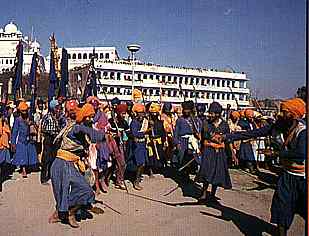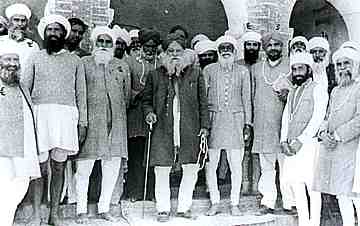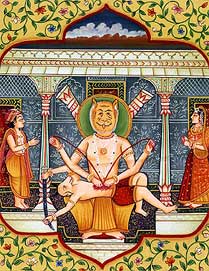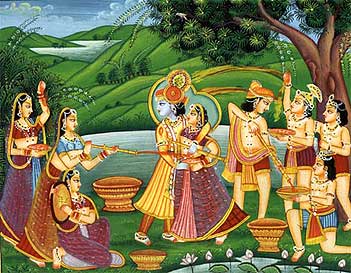

The transformation of' HOLA MOHALLA from 'Holi was first perpetuated by Sri Guru Gobind Singh Maharaj, who in A.D. 1699 created the 'Khalsa (the pure one) at Anandpur and subsequently this festival was given an uplift with the inclusion of Martial Arts as one of its salient features. Guru Ji divided his Army into two groups and made them fight mock battles -hence strengthening their military techniques and fighting abilities. During and after the Sikh Raj the 'Hola Mohalla' took a different turn. Drunkards and courtesan dances marred the holy festivities. In fact, the majority of the Sikhs were degenerated and behaved in a fashion contrary to the ideals and discipline laid down by Guru Gobind Singh. The Sikhs indulged themselves in all kinds of vices and forgot the Gurus' teachings.
This pathetic state of the Sikhs was witnessed by Satguru Ram Singh with his own eyes and after studying the downfall of the Khalsa, he came to a conclusion whereby the moral and physical character of a Sikh could be elevated. During April 1857 he baptised the Sikhs and rejuvenated the depleted Khalsa.

The old 'Hola Mohalla' of Guru Gobind Singh was again re-inacted and resurrected by Satguru Ram Singh and at Anandpur the Hola Mohalla was celebrated with a record breaking attendance, where the festivities accomplished the standard of Guru Gobind Singh's time. Subsequently the festival became a very prominent item in the Namdhari World until A.D. 1872 when Satguru Ram Singh was exiled by the British to Rangoon and then to Margui
The Namdharis and the successor of Satguru Ram Singh, Satguru Hari Singh suffered the atrocities of the British, who constantly kept a strict watch on the Namdhari H. Q., the village Bhaini, and at the entrance of the residential house. The inmates of the house were searched every time they went out or came in. Satguru Partap Singil was born under these conditions of semi - captivity - hence the 'Hola' was never celebrated as a festival, until the relaxation of the British surveillance, when Guru Hari Singh after a lapse of nearly 27 years, in AD 1898 celebrated the Hola in a village in Sialkot namely Guru Chak. Since that day the 'HoIa' celebrations have been quite consistent until the present time.
The festivities of Hola are performed for a period of four days, which include all kinds of religious programmes, concerts, exhibitions etc.
As the birth anniversaries of Guru Balak Singh , the 11th Guru and Satguru Partap Singh fall near this festival, the festival is enjoyed with two more auspicious occasions by the Namdharis.
Namdharis believe in strict teetotalism. In the matter of marriage they shun the caste restrictions. People of any caste are permitted to join the Namdhari faith. Truthfullness, simplicity in thought and action, righteousness, adoption of fair and honest means of earning livlihood, giving one tenth of the income to charity, helping the poor and needy, service of fellow beings in distress, the willingness to make sacrifice for the sake of motherland are the main tenets of the Namdhari faith.
All these features are highlighted during the festival where it attracts members of all the communities as well as compatriots, who believe in equality, fraternity and world peace.

To send a greetings card, kindly log on to
HOLI
Whether you are in a town or village, you must watch your step for a few days during spring. As you are strolling along without a care in the world a balloon filled with coloured water hurled down from a balcony, rooftop or corner may explode on your clothes, or suddenly an unseen hand squirt you with a well-aimed coloured-water spray. And if you are travelling by bus, it is wise to put down the shutters of the windows, otherwise without any warning you may find your clothes dyed with hues of many colours.

People playing holi
All is forgiven during Holi, for Holi is a festival
of joy, a festival to get to know each other better and wash out old grievances.
Every man, woman and child has clothes drenched in colour and faces smeared with
coloured powder. Thoroughfares are thronged with groups dancing and singing Holi
songs to the accompaniment of drums or cymbals—as they run into each other,
everyone smears gulal powder on everyone else, and hugs and embraces are exchanged.
In the lanes and bylanes coloured powder hangs like a mist and the air is full
of joyous cries:
It is Holi, brother, Holi - Mother Holi, blessings bears
May
our children live a million years.
You can witness this spectacle in
any town or village of northern India. Holi, like Diwali and Dussehra, is among
the most important Indian festivals and is celebrated all over thecountry, except
in some regions of the south. Even Indians living abroad celebrate it with enthusiasm.
It is a great leveller because on this day the old and young, rich and poor are
all regarded as equals.
In the first place, Holi is the festival of spring
and marks the rekindling of the spirit of life—new leaves sprout on the branches
of trees, the mustard flower is in bloom in several areas, gardens and parks are
a riot of colour and all is seemly. Human beings, who remained enclosed indoors
against the cold winds, and hibernating animals emerge to see a new world of colour
and gaiety. Hearts are filled with hope and thoughts turn to love. Holi marks
the change of seasons, the start of summer, the end of the days of trial and tribulation
for the poor who are ill-clad and without adequate shelter, and the beginning
of a new life. Why shouldn't it be welcomed with joy!
For the farmer it is
the festival celebrating the new harvest. The winter crop (rabi) is ripe, the
ears of wheat are golden and the farmer's heart is full of hope and gratitude.
At the same time Holi also marks the beginning of the new year. According to some
Indian astrological calculations, New Year's Day occurs two days after the Holi
bonfires are lit. By the Christian calendar, Holi falls some time in February-March.
Holi
is associated with Lord Shiva and is a recreation of his marriage procession.
The smearing of faces and drenching clothes with coloured powder and water is
done in honour of this deity, as is the singing and dancing to the beat of mridangs.

Lord Shiva
A more famous episode connected with Holi is the encounter
between Prahlad and his father Hiranyakashyapu. It is said that Hiranyakashyapu
was a very powerful demon-king. In the wars between the gods and demons, Hiranyakashyapu
gained victory over the gods. This made him so haughty andarrogant that he issued
an edict forbidding his subjects from taking the name of the Supreme Deity, and
threatened to mete out harsh punishment to anyone who disobeyed him. So his subjects
turned from the worship of God to the worship of their king.
Hiranyakashyapu's
son Prahlad was a worshipper of God. He refused to obey the order and continued
praying as before. His father dealt out severe punishment to him but he came out
unharmed.

Prahlad being saved by Lord Narsimha who killed Hirankashyap
Hiranyakashyapu
had a sister, Holika, who was blessed with special powers—fire could not
burn her. Hiranyakashyapu ordered Holika to take Prahlad in her lap and mount
a burning pyre. She did so, but Prahlad came out unscathed while Holika was reduced
to ashes. It is said that Holi is celebrated and Holi fires lit in remembrance
of this miracle. A day before Holi, people start collecting logs and make piles
of them on some open ground. On Holi night they gather round the piles, beat drums,
dance and set the pyres ablaze. Children go round the fire singing:
Holi
Mother we crave thy blessings Give us lives of millions of years.
Preparations
for Holi begin a few days earlier. Houses are whitewashed and colourful rangoli
designs drawn at the entrance. Flowers of the Flame of the Forest used to be collected
to make paint but today coloured powders and water syringes are easily available.
In many village homes, however, the gulal powder made of rice flour mixed with
turmeric is still ground by members of the family and children make their own
syringes from bamboo poles. These syringes have a hole at one end and a stick
with a knob made of rags as the piston.
In some regions, special dances are
performed for Holi. For these, sticks of two different sizes are made from wood
which is yellow at one end. The longer stick is about a foot and a half, the smaller
one about ten inches long. The bark is stripped off and the sticks painted in
different colours. The dancers strike the sticks together as they spin and whirl.
In Gujarat this stick-dance is considered the main attraction of Holi.
As on
other festivals, special delicacies are cooked on Holi. Several days before Holi
ghee, jaggery, sugar, raisins, almonds, pistachios and cornflour are brought and
stored in the larder. The delicacies vary from region to region but malpua made
of fresh bread soaked in sugar is common to all. In U.P. the favourites are gujhia
and papri made of cornflour. In Maharashtra it is puranpoli, a kind of sweet loaf.
In Gujarat it is millet bread known as thani. City folk today prefer to buy their
sweetmeats from the bazaar but in the villages Holi specialities are still made
at home.
I vividly recall a Holi festival I saw in a village in Himachal Pradesh.
Mattresses were laid out in the village square and large trays filled with gulal
powder were arranged on them. All the elders of the village were present. They
sang in chorus to the accompaniment of the harmonium, drum and tabla: "Who
shall play Holi with my beloved! Tell me who!" Then they formed a procession
and went singing and dancing from house to house. Old and young sprinkled powder
and squirted coloured water forgetting differences of age and status. Groups of
women worshipped the dandoch plant, and then everyone danced with coloured sticks.
All day long the hills reverberated to the songs of Holi.
In the evening the
entire village gathered in the main square to have darshan of their deities—Rama,
Krishna, Shiva and Parvati, Hanuman and Ganesh. This went on till after dark.
At about 10 p.m. the Holi bonfire was lit and all the colouredsticks and syringes
were thrown into the flames. Then everyone picked a charred bit of wood to take
home. This half-burnt piece is kept in the house for the rest of the year, for
villagers believe it keeps their homes free from disease.
In the cities, a
good week or ten days before Holi the bazaars are full of stalls selling coloured
powders, gulal, water balloons and syringes. Usually Holi is spread over two days—on
one the Holi bonfire is lit and on the other there is the squirting of coloured
water known as rang khel (play with colours). In the big cities, however, the
rang khel of Holi is restricted to a single day—and of that day only to the
morning. It is a colourful spectacle—groups of revellers, armed with buckets
of coloured water and syringes go singing, dancing, and sprinkling water on each
other. All this ends in the afternoon. People bathe, get into clean clothes and
go to musical soirees specially arranged for the occasion.

Krishna's sporting with the milkmaids during Holi has been the theme of many songs and a voluminous mass of literature has grown round it.
Because
of the close association of Lord Krishna with Holi the most famous celebration
of the festival takes place in Mathura and Vrindaban. Krishna's sporting with
the milkmaids during Holi has been the theme of many songs and a voluminous mass
of literature has grown round it.
The celebrations and rituals of Holi in some
areas are rather strange. In Nandgaon, the village of Krishna's birth and Barsanai,
Radha's home, women chastise men with sticks and the menfolk have to take the
beating with a smile and pretend to enjoy it. In Barmer in Rajasthan they throw
stones at each other and in Varanasi at Meeraghat the revellers divide themselves
into armies and attack each other with staves. The 'battle' is joined on Basant
Panchami and fought for two hours every day till Holi when it all ends peacefully—the
two armies embrace and daub each other with vermilion powder. The main attraction
of Holi at Varanasi, used to be in the wrestlingring named after Sivnath Singh
Bahadur Singh where it was celebrated with displays of swordsmanship; and at Durgaghati
with boxing and wrestling. These sports, however, aroused so much tension that
the authorities decided to ban them. But even today, on the day following Holi,
people march in a procession carrying staves, spears, swords and other weapons
as if going to battle.
What does Holi mean in the life of the people?
On
Holi we try to break the shackles of convention and let ourselves go, we try to
forget the innumerable obligations that weigh us down and breathe the air of freedom.
Original
Hindi: M.R. Kapur (with courtesy from 'Festivals of India)
For your HOLI CARDS visit
http://www.hindu-festivals.com
http://www.holi-ecards.com/links.html
Add a touch of colour to your dear ones life with your bright wishes through our collection of colourful Holi cards, Happy Holi Greeting Cards, Happy Holi Ecards.
http://www.higreetings.com/holiday/holi/
http://www.happy-holi.com/links.html